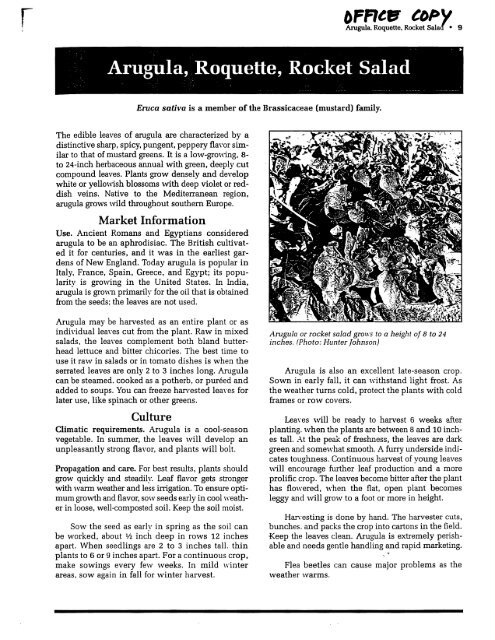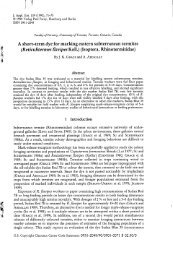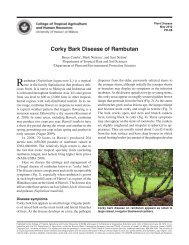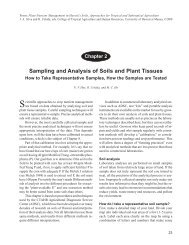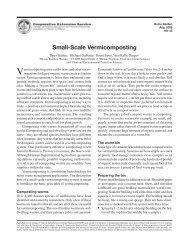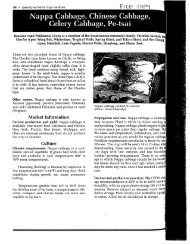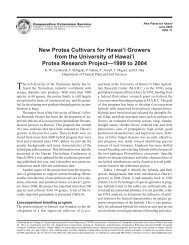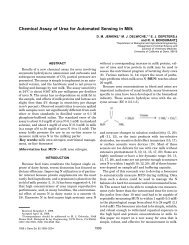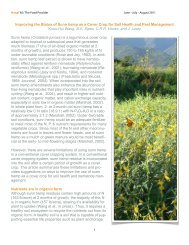Arugula, Roquette, Rocket Salad - ctahr
Arugula, Roquette, Rocket Salad - ctahr
Arugula, Roquette, Rocket Salad - ctahr
You also want an ePaper? Increase the reach of your titles
YUMPU automatically turns print PDFs into web optimized ePapers that Google loves.
<strong>Arugula</strong>. <strong>Roquette</strong>, <strong>Rocket</strong> <strong>Salad</strong> • 9<br />
<strong>Arugula</strong>, <strong>Roquette</strong>,<br />
<strong>Rocket</strong> <strong>Salad</strong><br />
Eruca sativa is a member of the Brassicaceae (mustard) family.<br />
The edible leaves of arugula are characterized by a<br />
distinctive sharp, spicy, pungent, peppery flavor sim<br />
ilar to that of mustard greens. It is a low-growing, 8-<br />
to 24-inch herbaceous annual with green, deeply cut<br />
compound leaves. Plants grow densely and develop<br />
white or yellowish blossoms with deep violet or red<br />
dish veins. Native to the Mediterranean region,<br />
arugula grows wild throughout southern Europe.<br />
Market Information<br />
Use. Ancient Romans and Egyptians considered<br />
arugula to be an aphrodisiac. The British cultivat<br />
ed it for centuries, and it was in the earliest gar<br />
dens of New England. Today arugula is popular in<br />
Italy, France, Spain, Greece, and Egypt; its popu<br />
larity is growing in the United States. In India,<br />
arugula is grown primarih' for the oil that is obtained<br />
from the seeds: the leaves are not used.<br />
<strong>Arugula</strong> may be harvested as an entire plant or as<br />
individual leaves cut from the plant. Raw in mixed<br />
salads, the leaves complement both bland butterhead<br />
lettuce and bitter chicories. The best time to<br />
use it raw in salads or in tomato dishes is when the<br />
serrated leaves are only 2 to 3 inches long. <strong>Arugula</strong><br />
can be steamed, cooked as a potherb, or pureed and<br />
added to soups. You can freeze harvested leaves for<br />
later use, like spinach or other greens.<br />
Culture<br />
Climatic requirements. <strong>Arugula</strong> is a cool-season<br />
vegetable. In summer, the leaves will develop an<br />
unpleasantly strong flavor, and plants will bolt.<br />
Propagation and care. For best results, plants should<br />
grow quickly and steadily. Leaf flavor gets stronger<br />
with warm weather and less irrigation. To ensure opti<br />
mum growth and flavor, sow seeds early in cool weath<br />
er in loose, well-composted soil. Keep the soil moist.<br />
Sow the seed as early in spring as the soil can<br />
be worked, about Vz inch deep in rows 12 inches<br />
apart. When seedlings are 2 to 3 inches tall, thin<br />
plants to 6 or 9 inches apart. For a continuous crop,<br />
make sowings every few weeks. In mild winter<br />
areas, sow again in fall for winter harvest.<br />
<strong>Arugula</strong> or rocket salad grows to a height of 8 to 24<br />
inches. (Photo: Hunter Johnson)<br />
<strong>Arugula</strong> is also an excellent late-season crop.<br />
Sown in early fall, it can withstand light frost. As<br />
the weather turns cold, protect the plants with cold<br />
frames or row covers.<br />
Leaves will be ready to harvest 6 weeks after<br />
planting, when the plants are between 8 and 10 inch<br />
es tall. At the peak of freshness, the leaves are dark<br />
green and somewhat smooth. A furry underside indi<br />
cates toughness. Continuous harvest of young leaves<br />
will encourage further leaf production and a more<br />
prolific crop. The leaves become bitter after the plant<br />
has flowered, when the flat, open plant becomes<br />
leggy and wall grow to a foot or more in height.<br />
Harvesting is done by hand. The harvester cuts,<br />
bunches, and packs the crop into cartons in the field.<br />
Keep the leaves clean. <strong>Arugula</strong> is extremely perish<br />
able and needs gentle handling and rapid marketing.<br />
Flea beetles can cause major problems as the<br />
weather warms.
10 • Specialty and Minor Crops Handbook<br />
Sources<br />
Seed<br />
NOTE: Seeds are widely available.<br />
More information<br />
Chandoha, Walter. 1984. Grow Italian greens. Organic<br />
Gardening. May 1984, pp. 80-84.<br />
Halprin, Anne, ed. 1978. Gourmet gardening, pp.<br />
189-91. Rodale Press, Emmaus, PA.<br />
Mansour, N. S. 1990. <strong>Rocket</strong>. Vegetable Crop<br />
Recommendations, Oregon State University, Corvallis,<br />
OR.<br />
Newcomb, Duane, and Karen Newcomb. 1989. The<br />
complete vegetable gardener's sourcebook. Prentice Hall<br />
Press, West Nyack, NY.<br />
Organic Gardening Magazine. 1978. The encyclopedia<br />
of organic gardening. Rodale Press, Emmaus, PA.<br />
Rubatzky, Vincent, and Mas Yamaguchi. 1997. World<br />
vegetables, 2d ed. Chapman and Hall, New York, NY.<br />
Stephens, James. Minor vegetables. 1988. Cooperative<br />
Extension Bulletin SP-40, University of Florida,<br />
Gainesville, FL.<br />
Whealy, Kent. 1988. Garden seed inventory, 2d ed. Seed<br />
Savers Publications. Decorah, IA.<br />
Prepared by Yvonne Sa\io and Claudia Myers.


